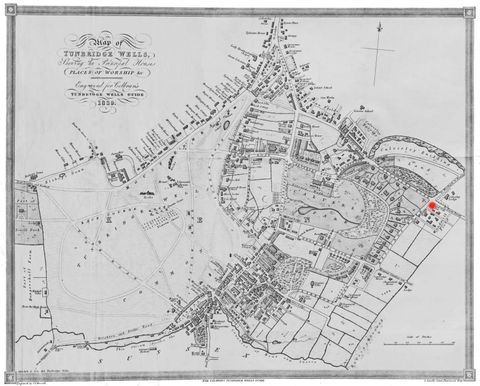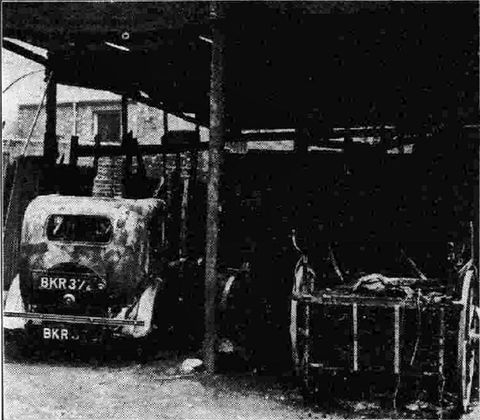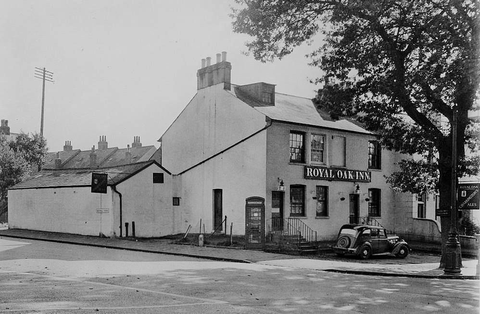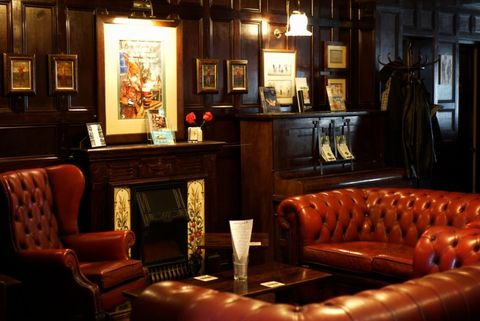Heritage
An Historic Pub
The Royal Oak has a long and colourful history, and is one of the oldest public houses in the town of Tunbridge Wells. Records show that the pub was probably built in the 1830’s (A map of the town from 1839 clearly displays The Royal Oak Inn), coinciding with the rapid development of the Calverley Estate by John Ward and his Architect Decimus Burton.
At this time the population of this area was growing fast - between the census of 1831 and 1841 there was a 40% increase in the population of the town. Around half of the population would have been manual workers (there were over 10,000 servants living in Tunbridge wells alone) and particularly those working at the elegant houses in Calverly park would have wanted a local inn to attend.
The Royal Oak has a long and colourful history, and is one of the oldest public houses in the town of Tunbridge Wells. Records of the pub's origin are few and far between (although many locals believe it dates back as far as the 1700's). A map of the town from 1839 clearly displays The Royal Oak Inn), coinciding with the rapid development of the Calverley Estate by John Ward and his Architect Decimus Burton.
At this time the population of this area was growing fast - between the census of 1831 and 1841 there was a 40% increase in the population of the town. Around half of the population would have been manual workers (there were over 10,000 servants living in Tunbridge wells alone) and particularly those working at the elegant houses in Calverly park would have wanted a local inn to attend.
Little is known about the early licensees of The Royal Oak. However, an early report from the Kent and Sussex Courrier in 1873 states that the pub was the venue of a public inquest into the grisly death of a local resident. The body of William Russell, a sawyer, of Windmill Fields, was discovered by his nine-year-old granddaughter, hanging from the bedstead by the neck. The Coroner, in summing up, remarked that the jury could have no doubt in this case. A verdict that “the deceased hung himself while in an unsound state of mind" was returned.
The 1881 Census lists a 36-year old Patrick Tracey as the "licenced victualler" at The Royal Oak Inn. Patrick lived here with his wife Sarah Jane, and their 3 children Henry, Ceily and Edith. Also living at the address were Patrick's sister Brigid, his father and mother in law (Isacc and Harriet Terry) and two servants (Alfred Lowe and Harriet Chesson).
Tracey had to deal with all of the usual issues that faced pub licensees at the time. A newspaper clipping from the Courier in February 1880 provides details of a court case in which it is alleged that George Henry Chestunt, a muffin seller, was summoned for being disorderly and refusing to quit the pub. Chestnut, it seems, became rather agitated when the landlady refused to draw him any more beer, on account of him being “quarrelsome and the worse for liquor”, and struck an innocent bystander at the bar three times, making his nose bleed.
At the court case, the defendant said he was very sorry for what had occurred, but owing to a few friends coming from London, he had a little too much to drink. He was fined 10 shillings, plus ten shillings costs, or 14 days hard labour.
One of the longest serving landlords at The Royal Oak was Alexander Saunders who ran pub from 1918 until 1938. During this time another event made the local headlines, when, on the morning of 12th June 1938, the wooden garages at the pub were discovered ablaze. Thankfully, due in part to the brave actions of several police constables and the fire brigade, the public house survived unscathed.
More recent history was made by The Royal Oak in October 2013 when the pub was made an Asset of Community Value, protecting it against any possible future redevelopment that would see it cease to trade. This was the first time a piece of legislation under the new Localism Act 2011 had been used in Tunbridge Wells to protect a building such as a pub or village hall.
Today the pub is owned and managed under the stewardship of the Beeson family, with Craig having taken on the role of licensee in April 2016. It remains a community-focused venue, with an emphasis on locally sourced food and drink products.
Little is known about the early licensees of The Royal Oak. However, an early report from the Kent and Sussex Courrier in 1873 states that the pub was the venue of a public inquest into the grisly death of a local resident. The body of William Russell, a sawyer, of Windmill Fields, was discovered by his nine-year-old granddaughter, hanging from the bedstead by the neck. The Coroner, in summing up, remarked that the jury could have no doubt in this case. A verdict that “the deceased hung himself while in an unsound state of mind" was returned.
The 1881 Census lists a 36-year old Patrick Tracey as the "licenced victualler" at The Royal Oak Inn. Patrick lived here with his wife Sarah Jane, and their 3 children Henry, Ceily and Edith. Also living at the address were Patrick's sister Brigid, his father and mother in law (Isacc and Harriet Terry) and two servants (Alfred Lowe and Harriet Chesson).
Tracey had to deal with all of the usual issues that faced pub licensees at the time. A newspaper clipping from the Courier in February 1880 provides details of a court case in which it is alleged that George Henry Chestunt, a muffin seller, was summoned for being disorderly and refusing to quit the pub. Chestnut, it seems, became rather agitated when the landlady refused to draw him any more beer, on account of him being “quarrelsome and the worse for liquor”, and struck an innocent bystander at the bar three times, making his nose bleed.
At the court case, the defendant said he was very sorry for what had occurred, but owing to a few friends coming from London, he had a little too much to drink. He was fined 10 shillings, plus ten shillings costs, or 14 days hard labour.
One of the longest serving landlords at The Royal Oak was Alexander Saunders who ran pub from 1918 until 1938. During this time another event made the local headlines, when, on the morning of 12th June 1938, the wooden garages at the pub were discovered ablaze. Thankfully, due in part to the brave actions of several police constables and the fire brigade, the public house survived unscathed.
More recent history was made by The Royal Oak in October 2013 when the pub was made an Asset of Community Value, protecting it against any possible future redevelopment that would see it cease to trade. This was the first time a piece of legislation under the new Localism Act 2011 had been used in Tunbridge Wells to protect a building such as a pub or village hall.
Today the pub is owned and managed under the stewardship of the Beeson family, with Craig having taken on the role of licensee in April 2016. It remains a community-focused venue, with an emphasis on locally sourced food and drink products.






